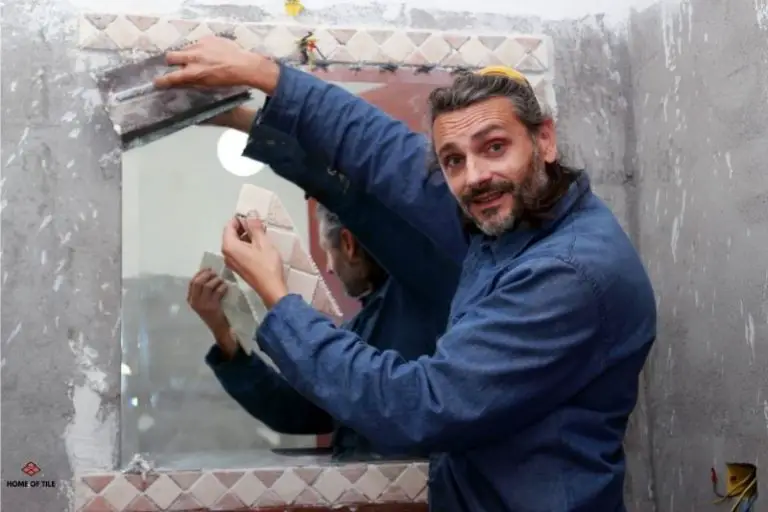How To Replace Ceiling Tiles, 8 Things You Should Know
If your ceiling tiles are getting old or starting to fall apart, it may be time to replace them. However, if you’ve never done this before, it can be a daunting task! This article is your guide to everything you need to know before you replace your ceiling titles.

Contents
How To Remove Ceiling Tiles
The process of removing your old ceiling tiles depends on which kind of ceiling tiles you have. The most common styles of ceiling tiles include drop ceiling and interlocking.
Drop ceilings feature suspended tiles that are installed directly over the original ceiling, and they’re mainly used to hide any piping or ductwork that’s visible on the original ceiling. They are usually simple white tiles.
Interlocking ceiling tiles are mounted directly on or near the original ceiling with crisscrossed rails or wooden strips. They’re a bit more complicated than drop ceilings; therefore, the removal process is also more complicated. Let’s take a look at how to remove these types of ceiling tiles:
Removing Drop Ceiling Tiles
Removing drop ceiling tiles is relatively straightforward, and it doesn’t require any specialized tools.
To remove a drop ceiling tile, follow these steps:
- Put on protective glasses to protect yourself from falling debris. I recommend these Dewalt Protective Safety Glasses (available on Amazon.com) because they come with rubber-tipped temples, which makes for a more comfortable fit, and the distortion-free lens prevents eye fatigue. Wearing safety gloves is also a good idea to protect your hands from injury.
- Place a chair underneath the tile you wish to replace. You may need a ladder if you’re not tall enough to reach the ceiling while standing on a chair.
- Push on the tile you want to remove. It should lift right out of the ceiling frame.
- Tilt the tile slightly to remove it from the frame.
- Repeat as needed with any other tiles.
As long as you follow these steps, you should be able to remove the drop ceiling tiles safely.
Removing Interlocking Ceiling Tiles
Removing interlocking ceiling tiles is a little more complicated. You’ll need a sharp utility knife and a metal scraper for this job.
Once you have all the necessary tools, follow these steps:
- Put on protective eyewear and safety gloves.
- Place a chair or a ladder on the floor to reach the ceiling. If you don’t feel stable on the chair or ladder, ask someone to hold it in place as you work on the ceiling.
- Run a utility knife blade through any seams between the tile you wish to remove and any other tiles.
- If the tile comes out immediately, you’re in luck! If not, proceed to the following step.
- Pry out any stubborn tile with your metal scraper.
- Remove any remaining glue or staples with your metal scraper.
You should always be extremely careful when removing interlocking ceiling tiles because you don’t want to get a staple in your eye.
Replacing Ceiling Tiles
How you replace your ceiling tiles depends on whether you have a drop ceiling or an interlocking ceiling, just like when you removed the tiles.
If you have a drop ceiling, the process of replacing the ceiling will be much simpler than if you have an interlocking ceiling. The first step in both processes is acquiring a new ceiling tile or multiple tiles. You can buy ceiling tiles online or at a home improvement store.
Replacing Drop Ceiling Tiles
Replacing a drop ceiling tile is an extremely straightforward process. In fact, part of the reason drop ceiling tiles are so popular is because of their ease of installation.
Below are the steps to follow:
- Put on protective eyewear and gloves.
- Place a chair or ladder underneath the area that needs a new tile.
- Lift your replacement tile at a 45-degree angle to fit within the frame.
- Once you have the tile within the frame, straighten it out and lower it, so it rests on the frame.
- Ensure it’s flush with the other tiles and securely in position.
That’s it–you’re done! You don’t need tools or glue to replace a drop ceiling tile. All you need to do now is determine what you’d like to do with the old tiles.
Replacing Interlocking Ceiling Tiles
Replacing an interlocking ceiling tile is slightly more complicated but still doable. Follow these steps:
- Put on gloves and protective eyewear.
- Place a chair or a ladder underneath the area where you need to insert a new tile.
- Insert the lips of your replacement tile in the grooves left behind from the old tile, ensuring that the edges are flush with the neighboring tiles.
- Staple or glue the tile down with construction adhesive. If you’re using construction adhesive, apply the glue to coincide with the wood grid the tile will match up with.
Then, you’ll need to ensure that the tiles stay in place and don’t sag. You should be good to go if you follow the above steps!
Can You Recycle Ceiling Tiles?
You can recycle ceiling tiles as long as they don’t contain asbestos. How you recycle them depends on your local authorities, and you can call a local recycling facility to see if they accept old ceiling material.
If your ceiling tiles were installed in the last 30 years, there’s a good chance they don’t contain asbestos, making them suitable for recycling.
What To Do With Old Ceiling Tiles
Once you’ve replaced your ceiling tiles, you’ll be left with the old ones. To prevent them from ending up in a landfill, you can recycle, donate or sell them.
Believe it or not, someone else may get use out of your old ceiling tiles! Try listing the tiles on Craigslist, Facebook Marketplace, or another online marketplace to see if you can get some cash for your trash.
If you can’t get money for your ceiling tiles, you could always donate them. Some communities accept old ceiling tiles for use in new buildings, such as new schools or hospitals. This could be your opportunity to help those less fortunate.







